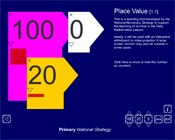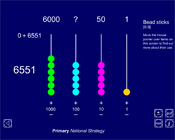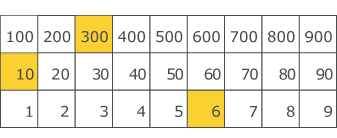Consolidation and practice
These resources are to support children in guided or independent work. Roll over the highlighted resources for a description.
Place value

This interactive teaching program (ITP) is an ICT-based tool to support the exploration of place value. Place value ITP allows the child or teacher to represent, partition and recombine three-digit numbers. Each digit can be represented as a group of dots to develop children's understanding of the significance of different digits.
Bead sticks

This interactive teaching program (ITP) is an ICT-based tool to support the exploration of place value. Bead sticks ITP (version 9) allows the child or teacher to represent numbers (with up to four-digits) and explore addition and subtraction. An animation demonstrates the process of grouping and exchange.
Opportunities to use and apply
Possible contexts include:
- money and measures, e.g. How could you make £7.34 just using £1, 10p and 1p coins? Find some other ways.
- calculation, e.g. How could partitioning help you calculate 38 + 25?
- number patterns and sequences, e.g. 268, 278, 288... What is the rule? Give the next three numbers in the sequence.
- number problems and puzzles, e.g. If you add the digits of the number 201, they total 3. How many other three-digit numbers can you find with a digit total of 3? Write these in order, smallest first.
 Counting and understanding number
Counting and understanding number


